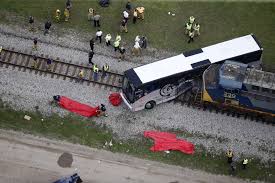
The hump on a notorious railroad crossing at Biloxi, Mississippi may be investigated as a possible cause of several fatal railroad accidents, including the tour bus accident earlier in March this year in which four passengers were killed.
The tour bus got stuck somehow as it attempted to cross the railroad crossing. It was there for only five minutes before a freight train plowed into its broadside, pushing the bus for several hundred feet down the track before it came to a halt.
The bus was carrying dozens of tourists to Mississippi casinos at the time of the crash. Four of them were killed outright and over 30 others were injured, some of them seriously.
There is no firm indication at this point what or who was to blame for the accident as it is still under investigation by the National Transport Safety Board (NTSB). The board investigators are looking into multiple possible causes, including the shape of the railroad crossing itself, the driver of the bus, the design of the bus, possible defects in the bus, and whether the train crew could have acted any differently to reduce the scale of the impact.
Biloxi Railroad Investigation
According to an NTSB board member, this particular railroad crossing has a ‘hump’ on it which has meant that tractor-trailers have got stuck on it before. The shape and incline at the railroad crossing is a particular focus of the NTSB investigation. There have been at least 17 accidents since 1976 involving collisions between vehicles and trains at this one crossing. “It sounds like a lot” was the reported comment made by Robert Sumwalt, the NTSB member. It sure does.
Families of the four tourists killed and the scores of injured people will certainly want to know who to blame for this accident, but they will have to wait patiently for the results of the investigation. It is vitally important in any personal injury lawsuit or wrongful death claim (in the case of any family member of the deceased who decides to file) that there is sufficient evidence available to prove fault. In many cases as complex as this, there may be no one individual party at fault. There may be several different factors and it may be the task of the personal injury attorney assigned to represent the plaintiffs to decide on the proportion of fault that will be in the claim. In this Biloxi accident, the injured and dead persons are unlikely to be the cause of the accident.
If the shape of the crossing was the main factor in the prevalence of accidents at this point, questions will be raised why the design of the crossing has never been changed after so many similar accidents. Were drivers of large trucks and buses aware that the crossing could potentially be a problem? Was there sufficient warning and did drivers take a risk using the crossing?
Sumwalt said that both the railroad and the city were responsible for the shape of the crossing, although CSX, the railroad company, says that it is the city alone that is responsible for the gradient. A CSX spokesperson said that there were 18 railroad crossings in a space of only 13 miles in the Biloxi area. The crossing where this particular accident took place had barriers, bells, and flashing lights to warn vehicles of an approach by a train, but these are obviously not much use when a vehicle is stuck on the crossing itself.
The train that hit the charter bus was traveling at around 26 mph (20 mph less than the maximum speed limit at this point) when drivers saw the stuck vehicle and put the brakes on. The bus was hit when the train slowed to 19 mph but was still pushed 200 feet down the tracks. Some of the tourists were trying to get off the bus at the time it was hit.
The complexity of such an accident is a good reminder of how important it is to have an experienced personal injury attorney working on your behalf to help negotiate a claim for compensation. If you are involved in any sort of vehicle accident in the Jackson area or anywhere in Mississippi do not hesitate but contact one of our experienced personal injury attorneys at the Diaz Law Firm. Ring us at 601-607-3456. We are committed to putting people first.